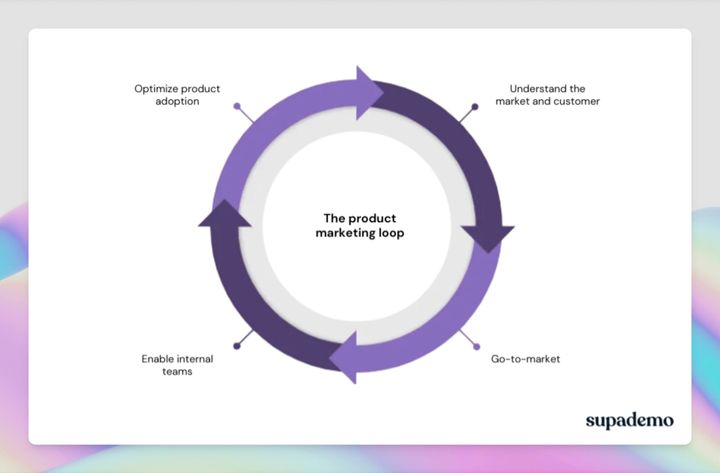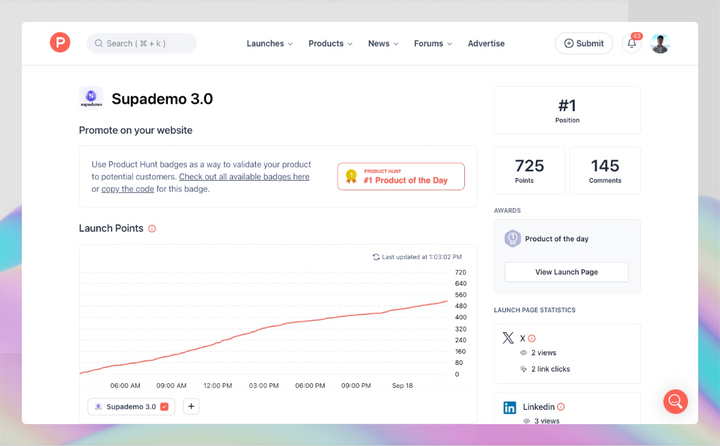Today, simply having a great product is no longer enough.
With countless options vying for customers' attention, effective product marketing has become a make-or-break factor for success. Companies that fail to communicate their product's value proposition clearly and compellingly often struggle to gain traction, while those that nail their product marketing strategies can skyrocket to the top.
This product marketing playbook is designed to equip you with the essential tools and strategies to elevate your product marketing game, ensuring your offerings resonate with your target audience, stand out from the competition, and drive sustainable growth.
What is Product Marketing
At its core, product marketing is about understanding and articulating the value of your product to your target audience. It's a strategic approach that combines elements of marketing, sales, and product development to create a compelling narrative around your product.
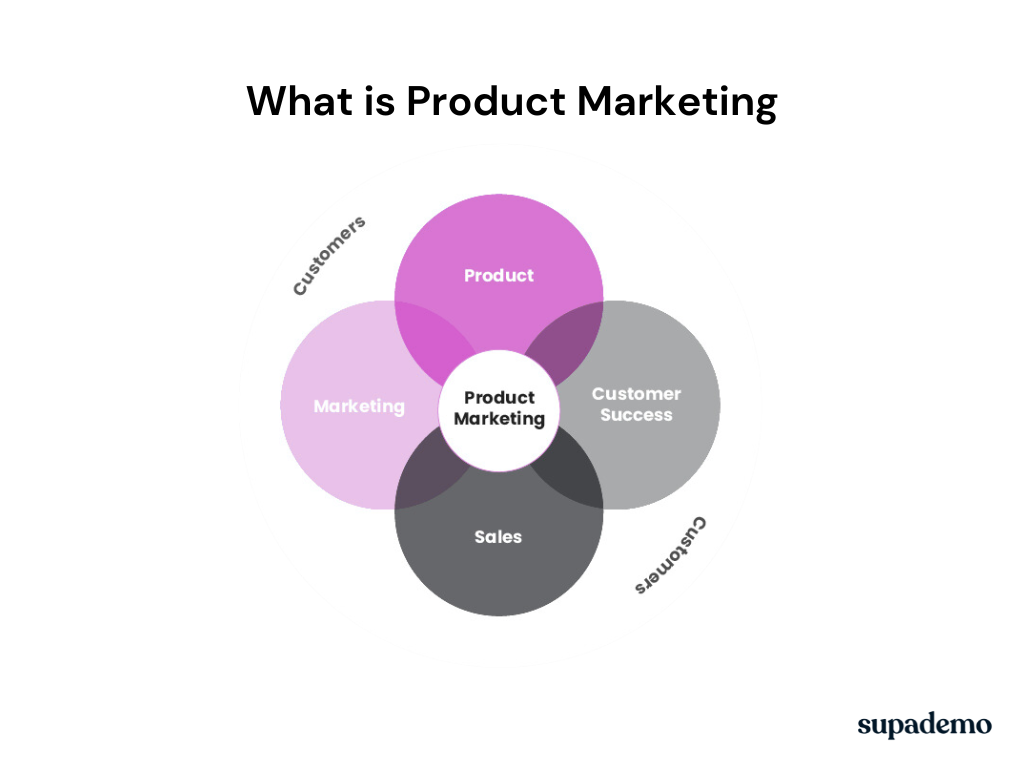
Product Marketing vs. Conventional Marketing
Product marketing is a specialized discipline focused on a specific product or product line, working closely with the product team to shape features, messaging, and positioning based on market insights. It involves in-depth market research to understand customer needs and competitive landscapes, informing product development and go-to-market strategies.
In contrast, conventional marketing takes a broader approach, encompassing a wider range of activities aimed at building brand awareness, driving customer acquisition, and fostering loyalty. While product marketers may focus more on outbound tactics like product launches and sales enablement, conventional marketing employs a mix of inbound and outbound strategies.
The key difference lies in their KPIs. Product marketers concentrate on short-term, product-specific metrics like adoption rates and revenue, while conventional marketing may have a longer-term outlook, tracking broader metrics like brand awareness and market share.
Here's a detailed breakdown of product marketing vs. growth/content/performance marketing
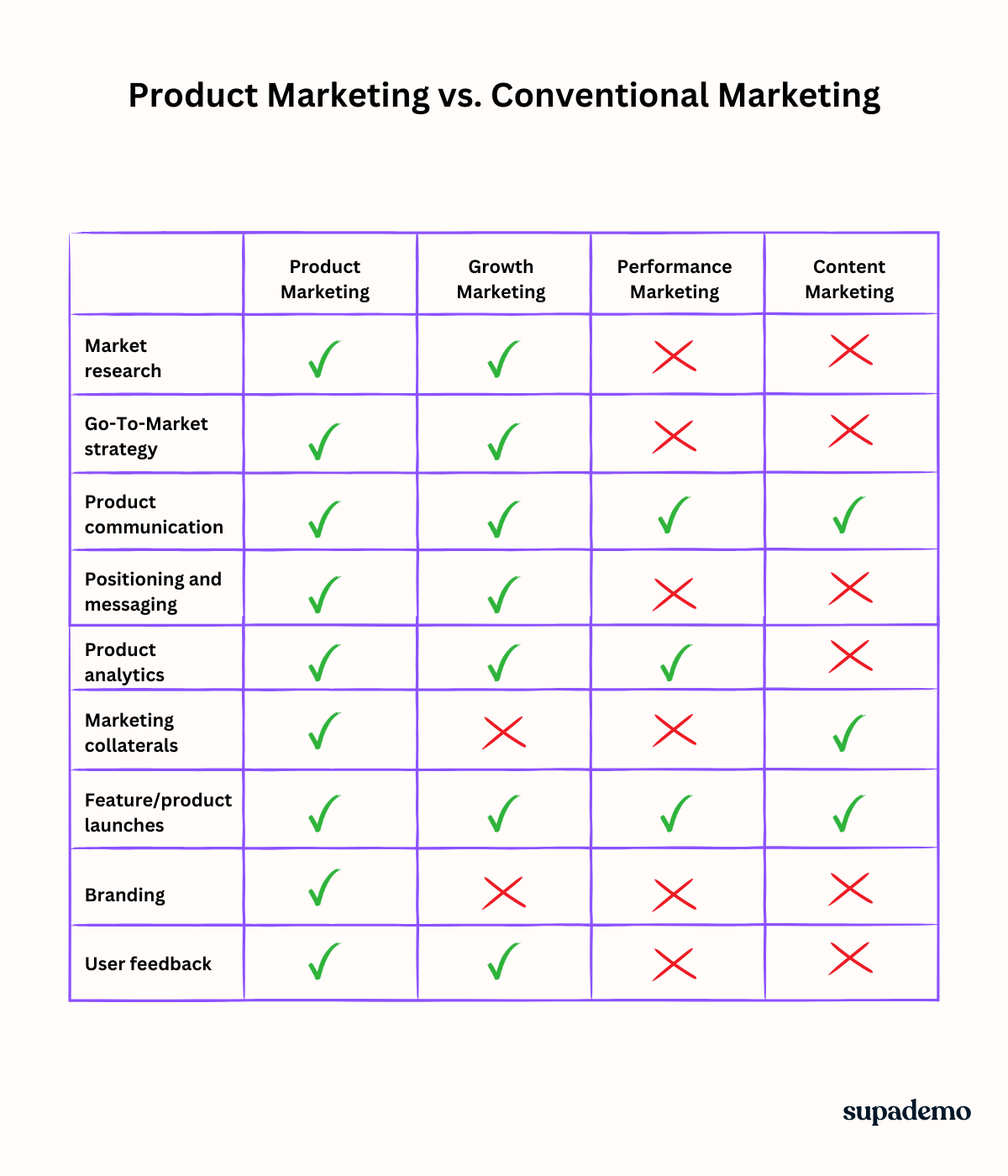
Product Marketing Loop
The product marketing loop is a continuous cycle that drives the success of a product throughout its lifecycle.
It begins with conducting in-depth market research to understand customer needs, pain points, and competitive landscapes. This insight informs the product development process, ensuring features and messaging resonate with the target audience.
Once the product is launched, product marketers execute campaigns to generate awareness, drive adoption, and enable sales teams.
Ongoing customer feedback and market analysis then guide product enhancements, pricing strategies, and future marketing efforts, allowing the product to remain competitive and relevant.
This iterative loop ensures a constant alignment between the product, marketing strategies, and evolving customer demands, fostering long-term success and growth.
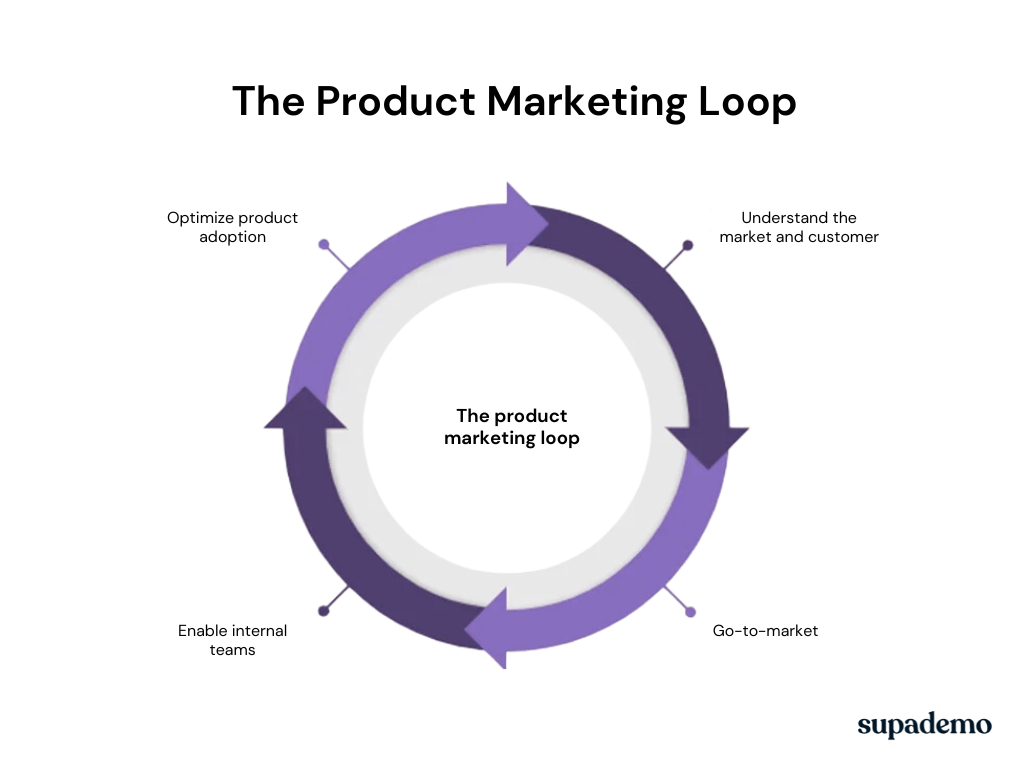
Product Marketing Responsibilities
Product marketers play a pivotal role in bridging the gap between a company's products and its target customers. Their responsibilities encompass a wide range of activities, including:
1. Audience Research and Monitoring
A core responsibility is to conduct in-depth research and continuously monitor the target audience to understand their needs, pain points, preferences, and behaviors. This insight is essential for informing product development and marketing strategies.
Here are a few questions product marketers should look into when doing target audience research -
- What does the audience care about?
- What are their pain points?
- What motivates them?
- How do they define success?
- What is their profession?
- What does a typical day in their life look like?
- Where do they go for information?
- How do they prefer to obtain goods and services? What is important to them when choosing a vendor? What do they value most?
- What are their goals?
2. Meeting Target Audience Needs
Product marketers work closely with product teams to ensure that the product offerings align with the identified needs and expectations of the target audience, maximizing product-market fit and customer satisfaction.

3. Product Positioning + Messaging
They determine the optimal positioning of the product within the market, differentiating it from competitors and effectively communicating its unique value proposition to the target audience.
A solid positioning strategy should include:
- Your target customer persona(s)
- How your product fits into the market
- The core benefits of your product
- Evidence
- Clarity
Here's a popular product positioning framework -
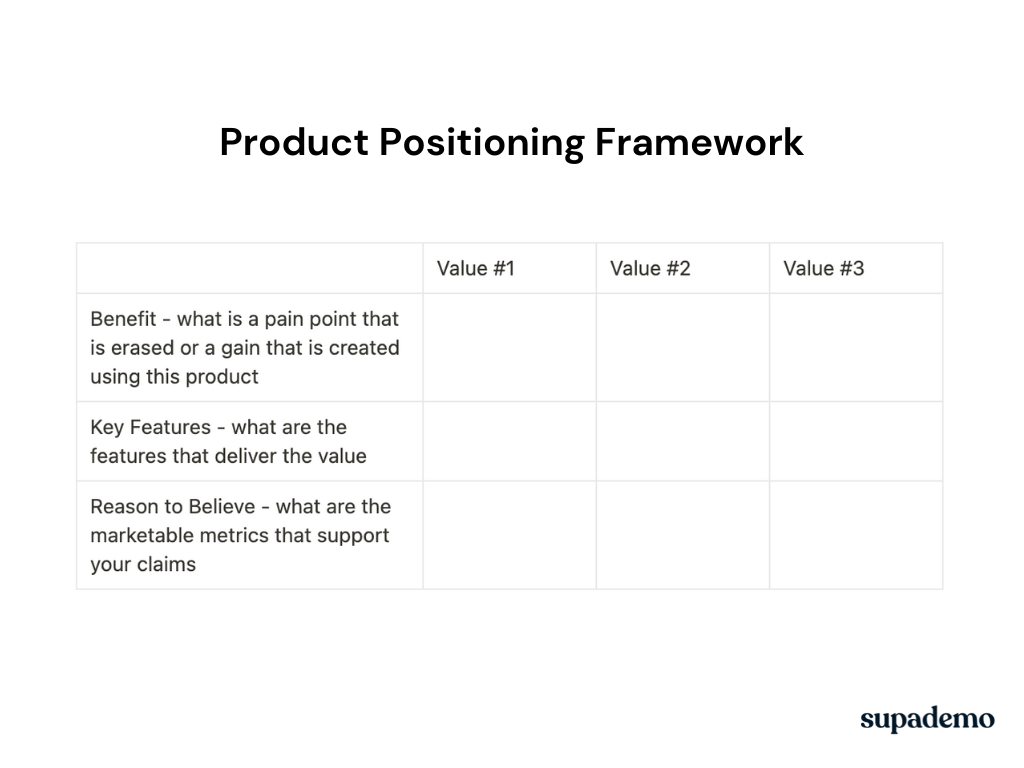
4. Product Marketing Strategy
Product marketers create, manage, and execute comprehensive product marketing strategies. These strategies encompass various aspects, including messaging, pricing, promotions, and go-to-market plans.
5. Sales Enablement
By providing the sales team with relevant product knowledge, training, and marketing collateral such as product guides, infographics and case studies, product marketers enable them to attract and engage the right customers effectively, ultimately driving product adoption and revenue growth. Here is an example of a sales follow-up collateral for Stripe:
6. Influencing Marketing and Product Development
Product marketers collaborate with cross-functional teams, influencing overall marketing strategies and providing valuable customer insights to guide product development roadmaps and feature prioritization.
7. Product Relevance
As markets and customer needs evolve, product marketers play a crucial role in ensuring that products remain relevant and competitive by continuously monitoring trends, gathering feedback, and recommending product enhancements or new offerings.
Why is Product Marketing Important?
Product marketing plays a critical role in ensuring the success of a product in the marketplace.
- Driving Product Adoption: Product marketers deeply understand the target audience's needs and pain points. They craft compelling messaging and positioning that resonates with customers, driving interest and adoption. For instance, when Slack market their messaging app, they highlight how it reduces email clutter and improves team collaboration.
- Maximizing Product-Market Fit: Through extensive market research, product marketers ensure that products align with customer needs, maximizing product-market fit. For instance, Fitbit's success stems from its ability to cater to the growing demand for fitness-tracking devices among health-conscious consumers.
- Enabling Effective Sales: By providing sales teams with relevant product knowledge, training, and marketing collateral, product marketers empower them to attract and engage the right customers effectively.
- Staying Competitive: Product marketers continuously monitor market trends, customer feedback, and competitor movements. This allows them to recommend product enhancements or new offerings, ensuring that products remain relevant and competitive. Apple's ability to stay ahead of the curve can be credited to their product marketers' understanding of evolving consumer preferences.
Product Marketing Strategy
1. Creating Buyer Personas
Developing detailed buyer personas is crucial for effective product marketing. These semi-fictional representations of your ideal customers help you understand their needs, pain points, and behaviors, enabling you to tailor your messaging and offerings accordingly.
Questions to consider:
- Who are your target customers (demographics, job roles, company sizes)?
- What are their key challenges and goals related to your product?
- How do they research and make purchasing decisions?
- What are their preferred communication channels and content formats?
To create buyer personas, conduct market research through surveys, interviews, and data analysis. Synthesize the insights into detailed profiles that capture their characteristics, motivations, and buying journeys.
2. Defining Differentiators and Positioning
Differentiating your product and positioning it effectively in the market is essential for standing out and resonating with your target audience.
Questions to consider:
- What unique features or benefits does your product offer?
- How does your product solve your customers' pain points better than competitors?
- What is your product's unique value proposition?
- How do you want your product to be perceived in the market?
Conduct a thorough competitive analysis, identify your product's strengths and unique selling points, and craft a positioning statement that clearly communicates your product's value and differentiation.
3. Setting Goals
Define clear, measurable goals to guide your product marketing strategy and measure its success.
Questions to consider:
- What are your target customer acquisition and retention rates?
- What revenue targets or market share do you aim to achieve?
- What adoption, engagement, or customer satisfaction metrics are critical?
- How will you measure the success of your product launches and campaigns?
Align your goals with your broader business objectives, and ensure they are specific, measurable, achievable, relevant, and time-bound (SMART).
3. Pricing Your Product
Pricing your product strategically can significantly impact its perceived value, adoption, and revenue potential.
Questions to consider:
- What is the perceived value of your product to your target customers?
- What pricing models or packages align best with your product and customer needs?
- How does your pricing compare to competitors' offerings?
- What pricing strategies (e.g., penetration, skimming) suit your goals?
Conduct pricing research, analyze your costs and target profit margins, and test different pricing models and packages to find the optimal balance between value perception and revenue generation.
4. Launching Your Product
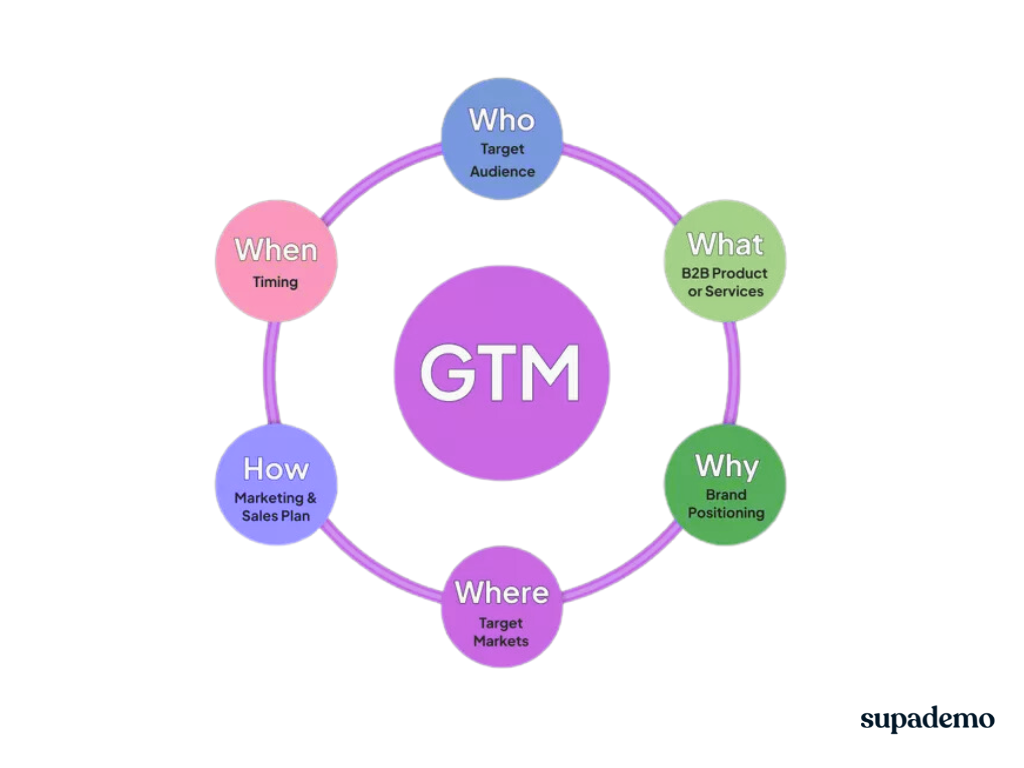
A well-executed product launch is crucial for generating awareness, driving adoption, and ensuring a successful market entry.
Questions to consider:
- What is your go-to-market timeline and launch plan?
- How will you coordinate cross-functional efforts (marketing, sales, support)?
- What launch campaigns, events, or promotions will you run?
- How will you measure and iterate on your launch strategy?
Develop a comprehensive launch plan that includes messaging, marketing campaigns, sales enablement, customer support, and metrics for continuous improvement. Coordinate closely with cross-functional teams to ensure a seamless and impactful launch.
There are multiple frameworks available to execute effective GTM plans. One popular framework is called the CCEBT framework -
- Channels: Identify the most effective channels to reach your target audience based on their preferences and behavior. This could involve market research, analyzing competitor channels, or leveraging existing customer data. Examples include social media platforms, email marketing, content marketing, events, or paid advertising.
- Communication: Craft compelling messaging that clearly communicates your unique selling proposition (USP) and resonates with your audience. Tailor your tone, style, and content format to each channel. Ensure your messaging addresses your target audience's pain points and highlights the value your product or service provides.
- Expectations: Set clear and measurable goals for your GTM campaign. These could include metrics such as website traffic, lead generation, sales targets, brand awareness, or engagement rates. Define what success looks like and how you'll track and measure it.
- Budget: Determine the budget required for your GTM campaign, considering expenses such as content creation, advertising costs, tools or software subscriptions, and any other necessary expenditures. Allocate resources effectively across channels and activities.
- Timelines: Establish a timeline for your GTM campaign, including start and end dates, as well as milestones and deadlines for specific activities or content creation. Ensure your timelines align with your campaign goals and allow for proper execution and measurement
Product Marketing Metrics and North Star Metric

In product marketing, it's crucial to measure the right metrics to track progress and success. A common approach is to align metrics with specific Objectives and Key Results (OKRs).
In product marketing, there are four main types of OKRs:
- Go-to-Market OKRs: These focus on metrics related to successful product launches, such as launch timeline adherence, messaging consistency, and sales enablement readiness.
- Product Adoption OKRs: These measure the uptake and usage of a product, including metrics like adoption rate, activation rate, and customer satisfaction scores.
- Sales Enablement OKRs: These track the effectiveness of product marketing efforts in empowering the sales team, such as the quality of sales collateral, training attendance, and win rates for targeted accounts.
- Lead/Demand Generation OKRs: These measure the impact of product marketing on generating qualified leads and demand, encompassing metrics like lead volume, conversion rates, and pipeline contributions.
Amidst these various OKRs, it's essential to identify a North Star metric – a singular, crucial metric that serves as the ultimate measure of success for the product and aligns the entire team's efforts.
Use Interactive Product Demos for Product Marketing
As a product marketer gearing up for a big launch, you’ve ticked all of your launch checklist tasks - customer-driven copy, compelling visuals, strategic placement of CTAs, and testimonials to build up the social proof.
But, your product marketing strategy is missing a key consideration.
- More than your landing page, buyers want to see the product in action.
- They want to test your product before they start working on the case to get buy-in.
- They need assurance that your product can solve their challenges by delivering the outcomes they’re hoping for.
Interactive product demos take care of these pain points. These demos reduce the gap between your product and buyers by giving them a frictionless way to experience its features in real time.
65% of teams report high impact on marketing engagement, and 59% see strong impact on product launch communication, according to our State of Interactive Demos 2026 report.
Product marketers are now leveraging interactive demos to:
- Create awareness and demand for your product
- Gather user feedback post-product launch
- Announce and showcase product updates
Supademo makes this job easier. With Supademo, you can easily replace static screenshots and unengaging video with step-by-step interactive demos in just a few seconds. This allows you to seamlessly demo products and features in minutes vs. hours of manual screenshots, scripting, re-recording and editing.
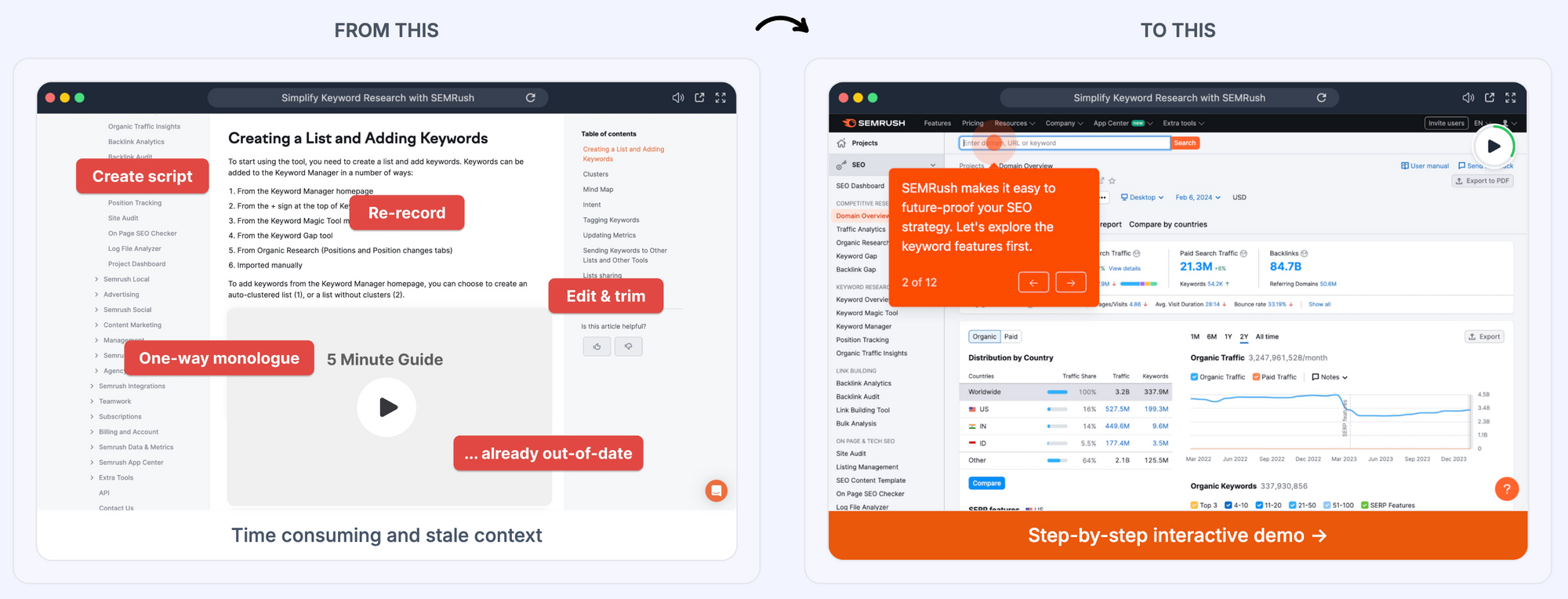
To get started, all you need to do is click here and start building demos for free, no credit card required.
FAQs
What is meant by product marketing?
Product marketing involves promoting and positioning a specific product or service to meet the needs of a target market while driving adoption and revenue.
What is PMM?
PMM stands for Product Marketing Manager, a role responsible for developing and executing marketing strategies for a company's products or product lines.
Why is product marketing important?
Product marketing is crucial for ensuring products align with customer needs, differentiating offerings, crafting compelling messaging, enabling sales, and driving successful product launches.
How do I start marketing a product?
Begin by understanding your target customers, their pain points, and preferences. Then, develop a unique value proposition, create a content strategy, and execute integrated marketing campaigns across relevant channels.
What are the 5 P's of product marketing?
The 5 P's are Product (meeting customer needs), Positioning (differentiating value proposition), Pricing (optimal strategy), Promotion (marketing campaigns), and Place (distribution channels).


